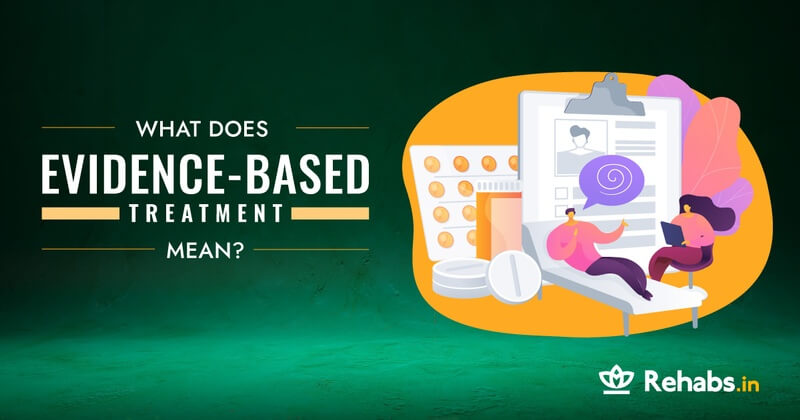Evidence-Based Treatment Explained – A Comprehensive Guide

When you are looking for addiction or mental health treatments, there are a lot of options. These treatments also include many claims relating to the working of a particular intervention. One can also get advice from friends and family, the internet, and news headlines. But the truth is, not all treatment modalities work equally. So, how does one know what is best for them?
Evidence-Based Treatments (EBT) give an individual the best chance for recovery. There are different perspectives on what it takes for a treatment to be considered evidence-based. In general, the scientific community analyses three main things – several research studies, their quality, and expert opinion. These treatments have been tested in multiple-phase research as it helps grow confidence in its viability.
Evidence-based interventions are typically an integration of research-based evidence and clinical expertise, along with patient values and experiences that lead to positive improvements in their health. The main goal of EBT is to encourage the safe use of effective treatments to achieve desired results.
History of Evidence-Based Practice (EBP)
EBT plays a crucial role in psychotherapy and general care of a person suffering from mental health and addiction problems. Its use may date back to centuries but did not gain attention until the 1990s as being relatively new. Evidence-Based Medicine (EBM) is a systemic approach to analyse published research as the base of their clinical decision making. In 1996, Sackett et al. defined it formally as the conscientious and judicious use of current best evidence from clinical care research in managing individual patients.
However, the developments in Evidence-Based Medicine (EBM) started around the seventeenth century when journals and textbooks became prominent. The modern EBM era finally hit its initial peak in the 1970s when technology began growing at an unprecedented speed.
Over time, the basic concepts included in the Evidence-Based Practice have expanded their horizon to include considerations of patients’ preference, clinical state, actions, and other circumstances.
The critical steps of EBM or EBP now include formulating essential queries based on the current problems, implementing the findings of the research, and evaluating specific outcomes.
EBP and Psychotherapy
Since the inception of EBP and psychotherapy, patients’ preferences are prioritised, giving them active choice options. A significant goal of EBP in psychotherapy is to maximise the patient’s choices for better understanding. Clinical decisions relating to Evidence-Based Therapies are generally made in collaboration with the patients themselves.
Prior attention is given to resources, relative costs and benefits, available means, and multiple other options. The decision-making in the process also involves continuous monitoring and adjustments. Such practices emphasise the patient’s environment, and their unique development characteristics like life stages, strengths, personal problems, functional status, readiness to engage in psychotherapy sessions, social support, and family dynamics.
Evidence-Based Treatment Interventions
Acceptance and Commitment Therapy
Acceptance and Commitment Therapy or ACT has shown positive results in treating mental health issues like anxiety disorder, depression, addiction, and other particular health issues. ACT is an empirical-based psychological intervention that uses a mix of acceptance and mindfulness strategies in multiple ways. In its initial years, this approach was called comprehensive distancing, which was changed to ACT in 1982.
The objective of acceptance and commitment therapy is not getting rid of complicated feelings rather than learning and moving towards valued behaviour. Its therapeutic effects also lead to positive emotions and a better understanding of the patient’s truth.
Dialectical Behavioural Therapy
Dialectical Behavioural Therapy (DBT) is similar to Cognitive Behavioural Therapy, it helps patients identify their negative thinking pattern to create a push towards bringing positivity. DBT is generally used to treat self-destructive behaviours and suicides by teaching various coping mechanisms to manage unhealthy behaviours.
Typically, a standard DBT treatment consists of four parts – individual therapy, group skill training, consultation for healthcare providers to maintain a positive overview, and phone coaching during crisis times. DBT is used to treat suicidal behaviours, borderline personality disorder, relationship, work, and personal well-being.
Cognitive Behavioural Therapy
Cognitive Behavioural Therapy (CBT) is a psycho-social intervention that aims at improving mental health by focussing on a person’s cognitive distortions like thoughts and beliefs. Devised initially for depression, its use has increased to treating a number of mental health issues like anxiety and irregular emotional patterns.
CBT is generally used to treat pre-diagnosed mental health disorders. The therapist and patient work collectively to find and practice effective strategies for dealing with various mental health issues to decrease the symptoms. Cognitive Behavioural Therapy has shown positive results against severe depression and anxiety, Post Traumatic Stress Disorder (PTSD), Borderline Personality Disorder (BPD), and eating disorder.
This form of therapy is also recommended as the first line of treatment in most mental health issues, especially for children and young adults.
Mindfulness-Based Cognitive Therapy
Mindfulness-based cognitive therapy (MBCT) is a category under cognitive behavioural therapy used for major depressive disorders. MBCT uses mindfulness practice to help improve the lives of people with high-stress and chronic clinical diseases. MBCT aims to interrupt automatic behavioural processes and teach people how to focus less on reacting to any stimuli.
The entire process aims at aiding a person in disengaging from being self-critical, dysphoric moods arising from negative energies, and rumination. Since MBCT focuses on recognising the pattern of thoughts that leads to contemplation, this aspect is responsible majorly for observed clinical outcomes.
Impact of EBT on PTSD and Depression
In the recent past, several studies that exhibit EBTs like cognitive behavioural therapy are highly effective against PTSD and depression. Since short-term evidence-based treatment interventions are used to treat substance abuse, PTSD, depression, and anxiety, it significantly reduces the overall costs of patient care.
The key components of CBT – cognitive restructuring and exposure therapy – help people make sense of their traumas or bad life experiences to become less sensitive to the subject over time. The active treatment through CBT engages patients to identify, understand, and change behaviour or thinking patterns. The skills learnt during the sessions are applied in their patient’s daily lives to support improvement.
Since depression and PTSD can affect individuals of every age, specific treatments are given to people based on their experiences and relevant response to it. Regardless of which intervention you choose, opting to see a therapist is also considered as one of the significant steps for treatment initiation.
A typical timeline for completion of EBT for PTSD and depression ranges between 12-16 weeks. However, it can extend or reduce, depending on the patient’s response.
Advantages and Misconceptions of EBT
Evidence-based treatment interventions offer significant advantages to its patients, practitioners, and clinical teams. When practised appropriately, EBT can complement clinical expertise while making final judgements on a patient’s condition. Applying evidence-based principles ensures that its practitioners use the best pieces of evidence as their starting framework and proceed accordingly.
It further helps professionals devise best-suited interventions and critically assess data as per the patient’s circumstances to determine prolonged treatment plans. Especially for patients with comorbidities multiple EBTs can be applied to give a start to their complex treatment plans.
Clinical teams actively deploying these interventions save time, capital, and resources as no ineffective or hit and trial method is used, which accelerates the costs involved.
EBTs also promote and implement safe, consistent, and cost-efficient psychotherapies. Therefore, these interventions are associated with high quality and accountability.
However, evidence-based treatments are also surrounded by many misperceptions affecting their adoption. One of the most significant misperceptions is that EBTs are methods that force mental health practitioners to replace their judgements with the ‘manualised procedures’ for treating the patients. As a matter of fact, most guidelines of all EBT interventions highly recommend clinical professional’s opinions or judgements.
All the treatments falling under EBT category are used in accordance with clinical expertise and patient’s preferences.
Treating Mental Health Problems with EBTs
When it comes to applying EBTs as a part of a patient’s regimen, its practitioners are assured that the intervention will work. With EBTs, a patient’s life can improve significantly. They are especially useful in cases of substance abuse and depression. While it is crucial for the patient to detox successfully before starting the intervention, they can opt for integrated, evidence-based treatments for avoiding chances of relapse. Evidence-based treatments are highly effective in treating addiction and comorbid mental health conditions simultaneously.
Sources
https://en.wikipedia.org/wiki/Mindfulness-based_cognitive_therapy
https://en.wikipedia.org/wiki/Cognitive_behavioral_therapy
https://www.webmd.com/mental-health/dialectical-behavioral-therapy#1
https://en.wikipedia.org/wiki/Acceptance_and_commitment_therapy
https://pubmed.ncbi.nlm.nih.gov/15827845/
https://www.ncbi.nlm.nih.gov/pmc/articles/PMC5509639/
https://adaa.org/understanding-anxiety/posttraumatic-stress-disorder-ptsd/treatment
https://www.ncbi.nlm.nih.gov/books/NBK390299/














